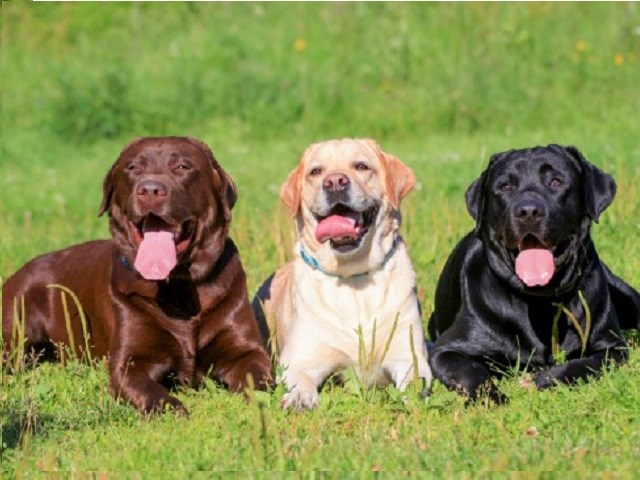Labrador Retriever Breed Information
At a Glance
| Male Height | 22 - 24 inches |
| Female Height | 21 - 23 inches |
| Male Weight | 65 - 80 pounds |
| Female Weight | 55 - 70 pounds |
| Size | Medium |
| Colors | Chocolate, Black and Yellow |
| Hypoallergenic | No |
| Personality | Adaptabable, Affectionate, Brave, Confident, Gentle, Intelligent, Loyal, Outgoing, Playful, |
| Lifespan | 10 - 13 years |
Introduction
Labrador retrievers (yellow, chocolate and black or charcoal) are a favored family dog due to their mild disposition and affectionate nature. They make a great pet for owners who spend time on or near to the water. They are also prized as gun dogs, and their ability to retrieve game fowl from water. Labs are are frequently used as guide dogs or to provide aid for the disabled or as therapy dogs Their smelling abilities and intelligence also mean that they are often used by law enforcement and military organizations - a truly versatile breed.
History
The Labrador is descended from the St John's Water Dog first bred in an area near Newfoundland Canada They were brought to England in the 1820s, where owners gave them the name Labrador to distinguish them from the Newfoundland (a gun dog from a near area). Originally the dogs were black only, and yellow and chocolate varieties were not accepted until the early 20th century. Labs are usually bred for confirmation at show events or as field dogs. The former tend to be chunkier and calmer, while the latter tend to be taller and thinner.
Temperament
They are great family members. The Purebred dog is regarded as kind, outgoing, gentle, loyal loving. affectionate and even tempered - always eager to please their masters. A great all around family dog.
Coat
The Labrador Retriever's coat is short and dense, but not wiry. The dog naturally has a slightly dry, oily coat that is water-resistant, so the dog does not get cold when taking to water in the winter. Although the AKC refers to the official colors as being either Chocolate, Black or Yellow, it may vary quite a bit. The yellow can range from an almost white cream to fox red. Chocolates can vary from medium to dark brown.
Do Labradors do well in Apartments?
Apartments are OK for Labs as long as they have enough space, and the owner is active enough to provide them with adequate exercise. Provided your willing to take him for run in the park or a swim in the river, and take him/her out for potty breaks.
Barking
Labradors are not territorial, so do not tend to bark, unless at noises from unknown sources. They get on easily with strangers and are not suitable as guard or watch dogs. If you have problems with you dog it can usually be attributed to you - make sure you give it enough attention and exercise.
Do Labradors Get Along With Children & Other Pets?
Labs are boisterous and a little hyper (at least during their early years), tend to underestimate their own strength, and can easily send a toddler flying. However their playful nature makes them ideal companions for older kids. Like most dogs Labs can be hostile toward cats, and vice versa. However, if the Lab is introduced as a puppy the two can get along quite well.
Exercising a Labrador Retriever
Labradors are sporting dogs and as such require a decent amount of exercise, and if inactive are one of the dogs most susceptible to obesity. Labs love to swim and are protected from the cold by their coats, so if your a water person they are ideal for you. If not they are just as happy fetching a stick or a ball like all good retrievers. These dogs need more than a walk around the block.
How to Groom a Labrador Retriever
To avoid excessive shedding, groom your Lab once a week with a natural or nylon bristle to remove loose fur. It is best not to bathe them often as this will dry out the skin and remove the natural oils that make their coat water-resistant. Do not use shampoo unless absolutely necessary.
Labrador and Shedding
The breed tends to shed hair twice annually or regularly throughout the year. Shedding can vary from dog to dog - but for the most part Labs are pretty low maintenance dogs and only require grooming once in a while.
Labrador Health Problems?
Hip and elbow dysplasia can be a problem in these dogs, especially if care is not taken in breeding. Conscientious breeders will always have hip scores to determine the degree of hip dysplasia in dogs before producing a litter. Other joint problems include luxating patella. Labs can also so suffer from genetic eye problems . However as with dysplasia most good breeders will access these conditions before breeding.
Are Labradors Intelligent?
Labrador Retrievers are one of the more intelligent breed, and can be trained to do a variety of tasks. Their willingness to please ensures that they quickly learn verbal commands. They rank in the top 10 breeds for intelligence
Labrador Retriever
Labs are one of the easiest dogs to train due to their intelligence, patience and mild manner. They are often used as guide for the blind and as assistance dogs for others. They are popular with law enforcement organization due to their working and detective abilities.
